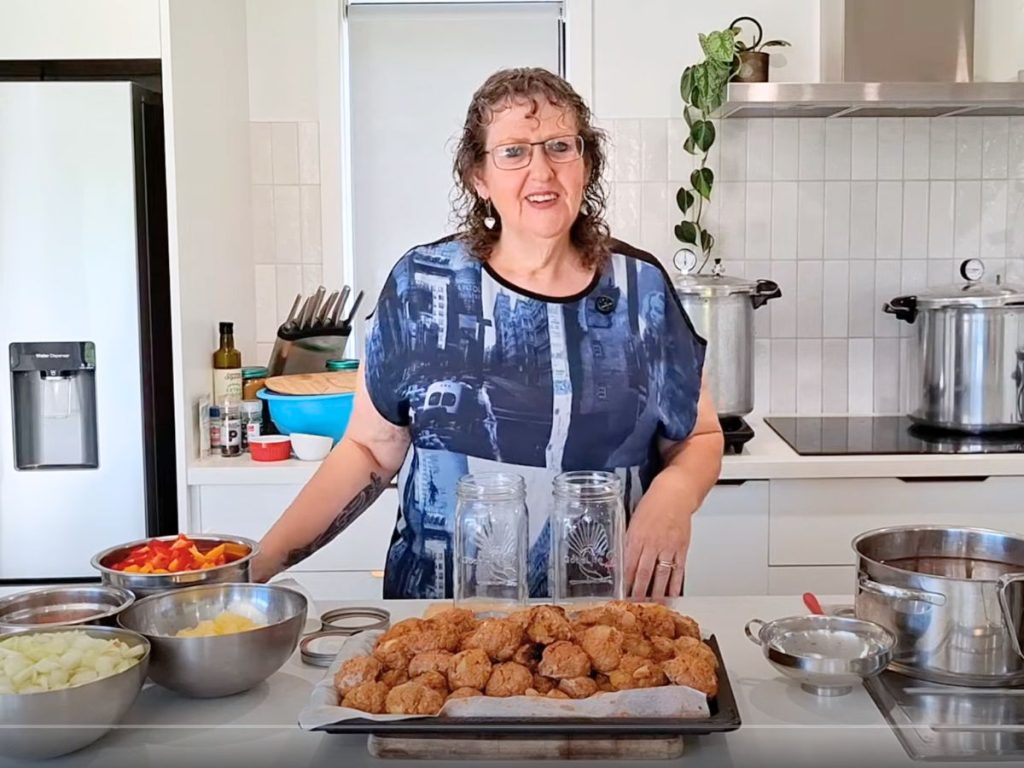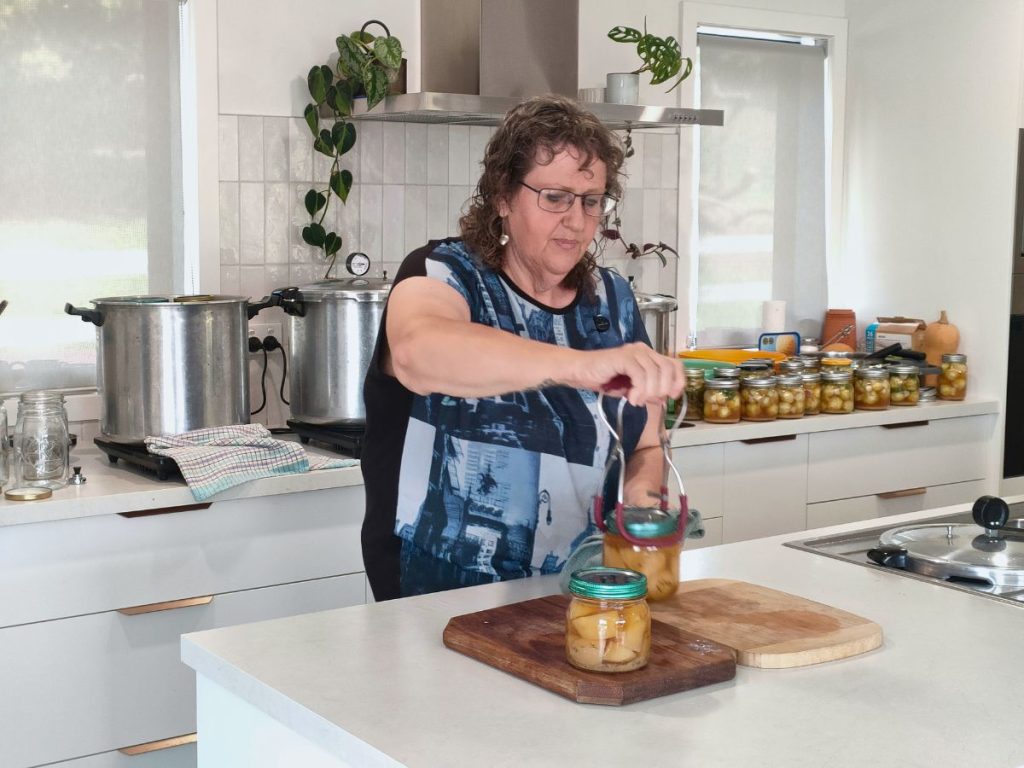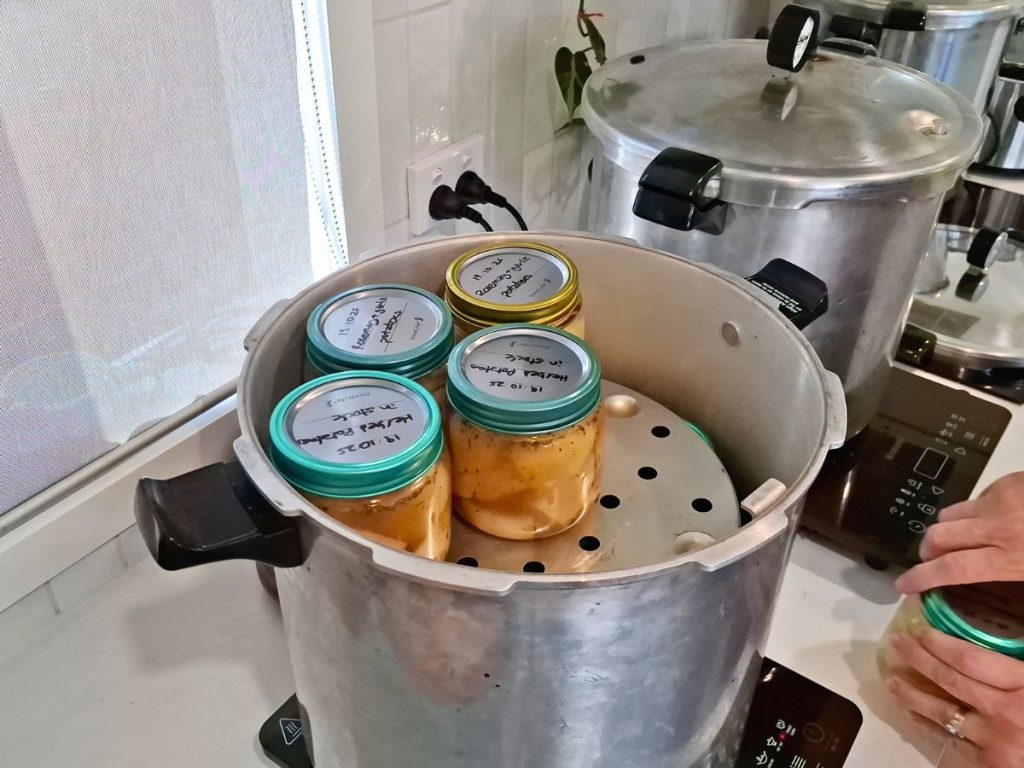Interview with Elle from The Potager Project and Katherine from Katherine’s Kitchen on beginner pressure canning and home preserving.
It’s filming day for our Jar by Jar Advanced and Beginner Pressure Canning Courses, and Katherine’s kitchen is buzzing with quiet energy. Two pressure canners hiss softly on the stovetop, jars are lined up on the bench like little trophies, and every so often there’s that familiar pop as a lid seals — the sound every home canner comes to love.
We’re surrounded by the organised chaos of preserving day: towels, tongs, bubbling pots, and the comforting aroma of pineapple and savoury mince. Between takes, Katherine laughs, “We’ve had the fridge full, then empty, then full again. Jars full — not empty — then full!” It’s such a perfect snapshot of her down-to-earth humour, the kind that immediately puts beginners at ease.
As the cameras reset, I take the chance to sit down with her and ask the questions that every new canner wants to know — the ones that turn pressure canning from something mysterious and intimidating into something simple, safe, and even joyful.
Q: Katherine, why does pressure canning still intimidate so many beginners?
Katherine: It’s the stories that have stuck around. Everyone knows someone who remembers a canner blowing up in Grandma’s kitchen — the lid in the ceiling, stew on the walls. Those memories are powerful! But the truth is, modern pressure canners are nothing like that.
She nods towards the humming Presto on the stovetop. “These Presto canners have multiple safety systems — rubber valves, locking lids, gauges. They simply won’t blow.”
The idea that pressure canning is dangerous is one of the biggest barriers for beginners. But once people see the process — how measured and calm it is — their fear disappears. “There’s no drama,” Katherine says with a grin. “Just quiet, steady cooking.”

Q: So how should someone approach their first attempt at pressure canning?
Katherine: Start small. Don’t try to fill the canner straight away — just do a few jars so you can learn the rhythm. The biggest thing is patience. Bring it up to pressure slowly, and let it cool down naturally. People often get nervous and try to hurry the process, but that’s where mistakes happen.
She also recommends keeping a notebook. “Write down what you canned, how long you processed it for, and how it turned out. It’s a great way to track what works. You’ll look back later and realise just how much confidence you’ve gained.”
This, she says, is what makes home preserving such a satisfying craft — you don’t have to master it all at once. “It’s a skill you build jar by jar.”
Q: What do you personally love most about beginner pressure canning?
Katherine pauses to glance at the jars cooling on the bench. “It’s empowering,” she says simply. “You can take food you’ve grown or bought and make it last all winter. You’re taking control of your pantry.”
Every pop of a sealing lid is a little victory.
It’s this sense of self-reliance — and the tactile joy of it all — that keeps her teaching. “They’re beautiful, aren’t they?” she says, nodding toward the jars. “You start with something raw and simple and end up with something nourishing. It’s practical, but it’s also deeply satisfying.”
Q: Why do you think learning to pressure can is making such a comeback?
Katherine: People are rediscovering the value of knowing where their food comes from. There’s a growing desire to waste less, save money, and make real food that lasts. Canning and preserving used to be about necessity — now it’s about mindfulness and sustainability.
With pressure canning, you can safely store meat, soups, stews, and full meals without relying on your freezer. That means more space, more independence, and more peace of mind when the power goes out.
Pressure canning isn’t old-fashioned,” she says. “It’s just smart, sustainable living.
In a world that moves fast and relies heavily on packaged foods, home canning feels like an act of grounding — a way to slow down, create, and nourish from scratch.

Q: What are the most common mistakes you see beginners make?
Katherine: Oh, everyone makes a few! But here are my top three when it comes to beginner pressure canning:
1. Rushing the process.
“If you skip venting or don’t wait for pressure to drop naturally, you’ll cause siphoning or broken jars.”
2. Forgetting headspace.
“Always leave the recommended gap at the top of each jar — usually an inch. The food expands, and that space keeps the seal clean.”
3. Leaving the screw bands on.
“Once your jars cool, take those rings off! If a seal fails later, you want to be able to see it.”
She laughs. “I learned some of these the hard way — cracked jars, messy lids, even a canner that buckled when I didn’t understand gas heat properly. But you know what? Every mistake is a lesson.”
Q: Can you explain what’s actually happening inside a pressure canner?
“Sure,” she says, clearly relishing the chance to demystify. “When you start heating your canner, the air inside is forced out through the vent. Once all that air is gone, it’s just steam inside — and steam under pressure gets much hotter than boiling water.”
That extra heat is what makes pressure canning safe for low-acid foods like meats and vegetables. “You’re hitting temperatures high enough to kill bacteria that a simple water bath can’t.”
The gauge or weighted jiggler helps maintain that pressure. “If your recipe says ten PSI, that’s ten pounds of pressure per square inch. You keep it steady by adjusting your heat. Once you get used to the sound of it — that little hiss and jiggle — you’ll know exactly when it’s happy.”
It’s a delicate balance, but one that quickly becomes second nature. “You start to listen to your canner the way you’d listen to a good stew simmering. It tells you when it’s ready.”

Q: You mentioned the courses earlier — how did Jar by Jar begin?
Katherine: It grew out of a shared idea that learning to preserve shouldn’t be intimidating. So many people want to learn to can food but don’t know where to start, or they’ve tried once and given up because it felt too technical. We wanted to change that.
Together, we built an online canning course that people can follow at home — with clear video lessons, simple recipes, and lots of encouragement. “It’s the next best thing to having someone right beside you at the stove,” she says.
There are now three courses:
- The Preserving Course – covering jams, chutneys, and water bath canning.
- The Beginner Pressure Canning Course – perfect for anyone starting from scratch.
- The Advanced Pressure Canning Course – for those ready to move into full meals in a jar, from hearty soups to savoury meats.
The courses are designed to build confidence step by step — and to make preserving feel joyful, not stressful.
We want people to realise this isn’t a mysterious art,” Katherine says. “It’s just good food, treated with care.
Q: What’s one piece of advice you’d give to someone about to try pressure canning for the first time?
Katherine’s answer comes without hesitation. “Just start with one jar.”
She laughs, hearing another lid ping in the background. “Hear that? That’s your reward. Once you hear that first pop, you’ll be hooked.”
She’s right — it’s addictive in the best possible way. That tiny sound carries the satisfaction of knowing you’ve taken raw ingredients and turned them into something shelf-stable, beautiful, and nourishing. “It’s not scary,” she says. “It’s rewarding. You’ll be proud of yourself every time you open a jar.”
Q: Any final thoughts for home preservers — especially those still sitting on the fence?
Katherine wipes down the counter as we wrap up the filming day. “Remember, everyone starts somewhere; just like starting your first vegetable garden! You don’t need a big kitchen or fancy gear — just curiosity and a bit of courage. Once you’ve learned the rhythm, you’ll realise how simple it really is.”
She nods toward the jars cooling on the bench. “That’s the best part about home canning for beginners — it’s a skill that stays with you. You’ll feed your family better, waste less, and feel more connected to what you eat.”
Wrapping Up: Confidence in a Jar
As the last of the canners cools, the kitchen smells of pineapple and savoury stew. The bench is covered in warm jars, each one a small symbol of patience and care. Watching Katherine at work, I’m reminded why beginner pressure canning has found new life among modern home cooks — it’s not just about food preservation. It’s about empowerment.
Every jar sealed is a small act of self-sufficiency, a quiet nod to the generations who came before, and a reminder that even in today’s fast-paced world, we can still slow down long enough to fill our shelves with something homemade and real.
If you’ve ever wanted to learn to can, to fill your pantry with confidence and flavour, or to take the mystery out of preserving, explore our online canning courses at JarByJar.com. From beginner pressure canning to advanced pressure canning, you’ll find everything you need to make this timeless skill part of your kitchen life.

About the Author
Elle Reed is a passionate gardener and advocate for teaching beginner gardeners how to grow their own food. Elle’s mission is to inspire and empower people to get back to basics, grow their own produce, and embrace a sustainable lifestyle. “Whether it’s a few herb pots in an apartment, a potager or a full garden plot, we can all ‘start somewhere’ to grow our own food, and in doing so, provide healthier food for ourselves and those we love”.




